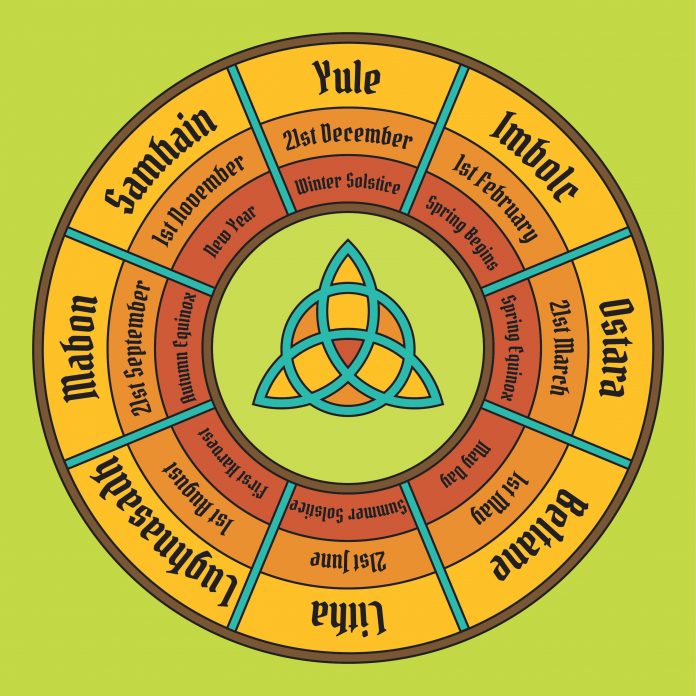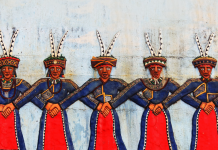(text: Iris Toister and Reverand Alon Kobets)
NATURE religions, pre-dating Christianity, visualised the year as a wheel with eight spokes. Each spoke is a major festival or a Sabbat. Solstices, Equinoxes, and midpoints between – also known as the Cross Quarters – have been celebrated by a variety of Nature peoples, also called Pagans, around the world and across the ages.
The rhythms of nature are easy to ignore in the modern world, where electric lighting takes away the terrors of the long and cold winter life. Most of us do not have to pay attention to the times of sowing and harvest, lambing and culling. Food is there for us in the stores, all year round. For our ancestors, the cosmic drama of seasonal change gave shape and meaning to life. They had no guarantee that the sun would return to them after its winter decline, and if harvest failed, they had few resources to fall back on. All ancient cultures paid close attention to the wheel of the seasons and their monuments often functioned as solar and lunar observatories.
The festivals of the wheel represent the active and dormant states of nature, man and agriculture. Each of the Sabbat days was ruled by a governing deity, whether a God or a Goddess, with each region having its own associated deity. From planting to reaping to winter to summer, the seasons were of great importance because living depended upon good harvests, mild winter and enough rainfall.
The festivals did not disappear with the rise of the monotheistic religions, Judaism and Christianity. Jewish authorities attribute many customs and doctrines of “Judaism” to Persian, Babylonian and Assyrian sources although festivals’ customs are less obvious then in Christianity. The word Sabbat, used to describe the festivals, is derived from Hebrew. It describes a day of rest, or cessation from labour. This rest day was compulsory, being a commandment from God Himself. The word Sabbat was implemented into the European languages by the Christians, along with other Hebrew words, such as Haleluja, or Amen, and is used to describe a holy day, not just the weekly Sabbat day.
Two mighty religious systems, Judaism and Paganism, prevailed when Jesus established his church. Judaism was strong on salvation by ceremonies. Paganism was known for its ceremonies connected to nature, and many gods. Both seeped into many of the churches. Even during the third century much of the religion of the times was little more than a compound of Paganism and Judaism with a slight seasoning of Christianity.
THE WHEEL OF THE YEAR
The Four Seasons are known as Solar Festivals, in that they mark a seasonal change caused by the Sun. The four Fire Festivals are usually celebrated as significant agricultural festivals. Together they make up the eight Sabbats of the Wheel. Different languages have different names for the eight Sabbats.
Started in Israel, such festivals are making a comeback. Mabon is one of such festivals, commonly celebrated between September 21–24 in the Northern Hemisphere and approximately six months further in Southern Hemisphere. It is also a celebration of the Autumn Equinox, when day and night are equal in both physical measurable time and immaterial spirit.
The Israeli festival Mabon 2011 was held between September 22 to 24 at an Eco farm in Southern Israel. The event stretched over three days, starting with some activities like workshops to decorate the place and prepare for the rituals to follow.
On the whole, there were three rituals held; one to open the festivities on the first day and declare the whole space as a holy ritual ground; the main ritual is held on the night of the second day, and the closing ritual on the early afternoon of the last day.
CELTIC WITH ASIAN ORIGINS
THE WAXING SUN
In the season of the waxing sun, the light is slowly getting stronger. It is early spring.
○ IMBOLC – FEBRUARY 2 – FIRE FESTIVAL
February is dark and wintry. Even so, the sun is waxing and the first signs of new life are beginning to appear. Imbolc celebrates the strengthening light, the first signs of spring, the first sprouting of leaves. It is a day to celebrate the passing of winter.
○ OSTARA – SPRING EQUINOX – AROUND MARCH 21 – SOLAR FESTIVAL
Day and night are equal. From now on, night declines and day lengthens. This is the pagan “Easter”, or rather, this is the day that christians “borrowed” to be Easter.
THE FULL OF THE SUN
Early summer is a time of new enterprises, the most popular time for marriages. people respond to the freshness of nature with new hope and energy.
○ BELTANE – MAY DAY – APRIL 30, EARLY MAY – FIRE FESTIVAL
In the hills of Northern Europe, Beltane was the season when the herds were driven to the summer pastures. In many places they were made to pass between two bonfires to rid them of evil influences. In early times, the Druids, the celtic priests, kindled the Beltane fires with specific incantations. Later, the christian church took over the Beltane festival. A service was held in church, followed by a procession to the fields or hills, where the priests kindled the fire.
○ LITHIA – MIDSUMMER SOLSTICE – AROUND JUNE 21 – SOLAR FESTIVAL
At midsummer solstice we celebrate the mystical marriage between heaven and earth, god and goddess make love. This sabbat glorifies the sun god and fire plays a prominent role in it. Although the warmest days of summer are still to come, the sun has reached its zenith and from this point on will be dropping lower in the sky.
THE WANING SUN
The lazy days of summer change into autumn. Light is softer, the forests turn red and gold, and the harvest is gathered in to stock and store for winter.
○ LUGHNASSAD – LAMMAS – AUGUST 2, EARLY AUGUST – FIRE FESTIVAL
Lughnassad commemorates Lugh, celtic god of light, and son of the sun. In the mythological story, the sun god transfers his power into the grain as it ripens, and is sacrificed when the grain is harvested, thus dying for his people so that they may live. It is then harvested and made into the first new bread of the season. Lammas is the festival celebrating the first fruits of harvest. An early christian festival, “Lammas” derives from the old English words for loaf and mass.
○ MABON – AUTUMN EQUINOX – AROUND SEPTEMBER 21 – SOLAR FESTIVAL
Technically, an equinox is an astronomical point and, due to the fact that the earth slightly wobbles on its axis, the date may vary by a few days depending on the year. The autumnal equinox occurs when the sun crosses the equator on its apparent journey southward, and we experience a day and a night that are of equal duration. up until Mabon, the hours of daylight have been greater than the dark hours. From now on, the dark grows.
THE DARK OF THE SUN
The winter months were a time of anxiety for our ancestors, a season to be endured and survived. To keep their spirits up, they studded the dark with festivals.
○ SAMHAIN (PRONOUNCED SOWEN) – HALLOWEEN – OCTOBER 31 – FIRE FESTIVAL
One of the most important sabbats in pagan year, samhain was the feast of the dead in pagan and christian times. Its arrival signalled the close of harvest and the start of the winter season. This was a feared time when the “veil between the worlds” was considered to be thin, the barriers between the human and the supernatural worlds were broken. people took precautions against witches and evil power.
○ YULE – MIDWINTER SOLSTICE – AROUND DECEMBER 21 – SOLAR FESTIVAL
Yule is the longest night of the year, when a festival of light and feasting is more or less psychologically necessary. All ancient European cultures celebrated at this time. Yule festival was associated with the birth of older pagan gods, death and resurrection. Around this time, Judaism celebrates the festival of Hanuka of lighting candles and family gatherings during eight days.
[/ultimate_ctation]
Since the Israeli Pagan community is small, but quite diverse, the organisers, had to come up with a ritual style that honoured everybody present, with their individual beliefs among other things, and at the same time be interesting and engaging enough to perform as a ceremony that everybody can attend together. It was quite a challenge, but the festival was considered a success.
THE WHEEL OF THE YEAR IN MODERN TIMES
Centuries of persecution, torture and execution of wise women, men and children, has led to the disappearance of Pagan religions, but many of the customs found their way into Christianity and Judaism. A rebirth of Paganism has started in the first part of the 20th century. Perhaps it is the decline of popular religion, perhaps a need to reconnect to nature’s stability, in times of uncertainty and a rapidly changing world.
Today, Wiccans and other Pagans often blend together ancient as well as contemporary approaches to celebrating these seasonal festivals. They believe that the earth is a living being whom we need to honour, and they try to minimise the damage they do to her through ecological movements. Their values, such as respect for life, a cheerful acceptance of the facts of life, such as sex and death, arise from observation and celebration of the natural world through the eight Sabbats of the Wheel of the Year.
For the rest of this article (Asian Geographic No.86 Issue 1/2012) and other stories, check out our past issues here or download a digital copy here




![The Road to Independence: Malaya’s Battle Against Communism [1948-1960]](https://asiangeo.com/wp-content/uploads/2021/07/WhatsApp-Image-2021-07-26-at-11.07.56-AM-218x150.jpeg)






